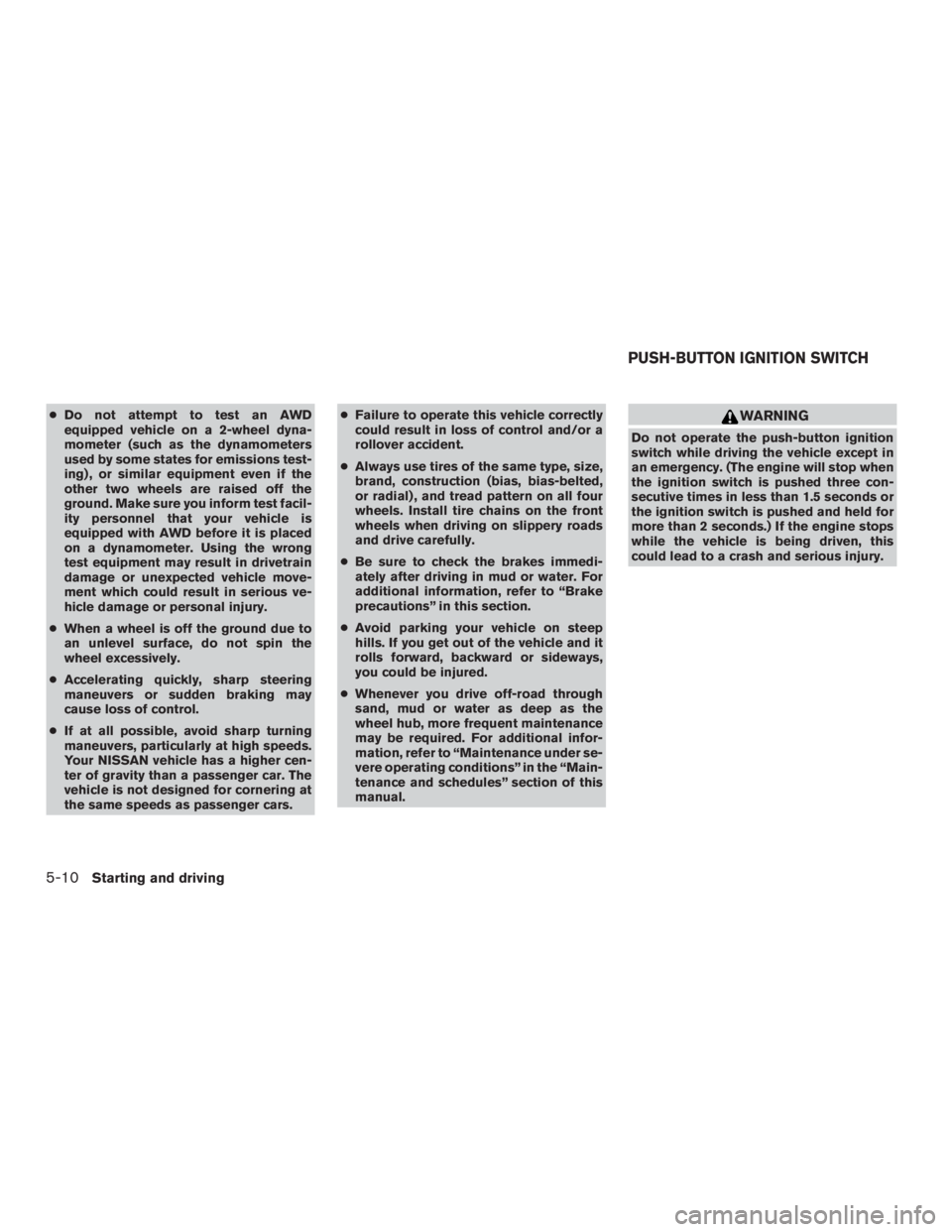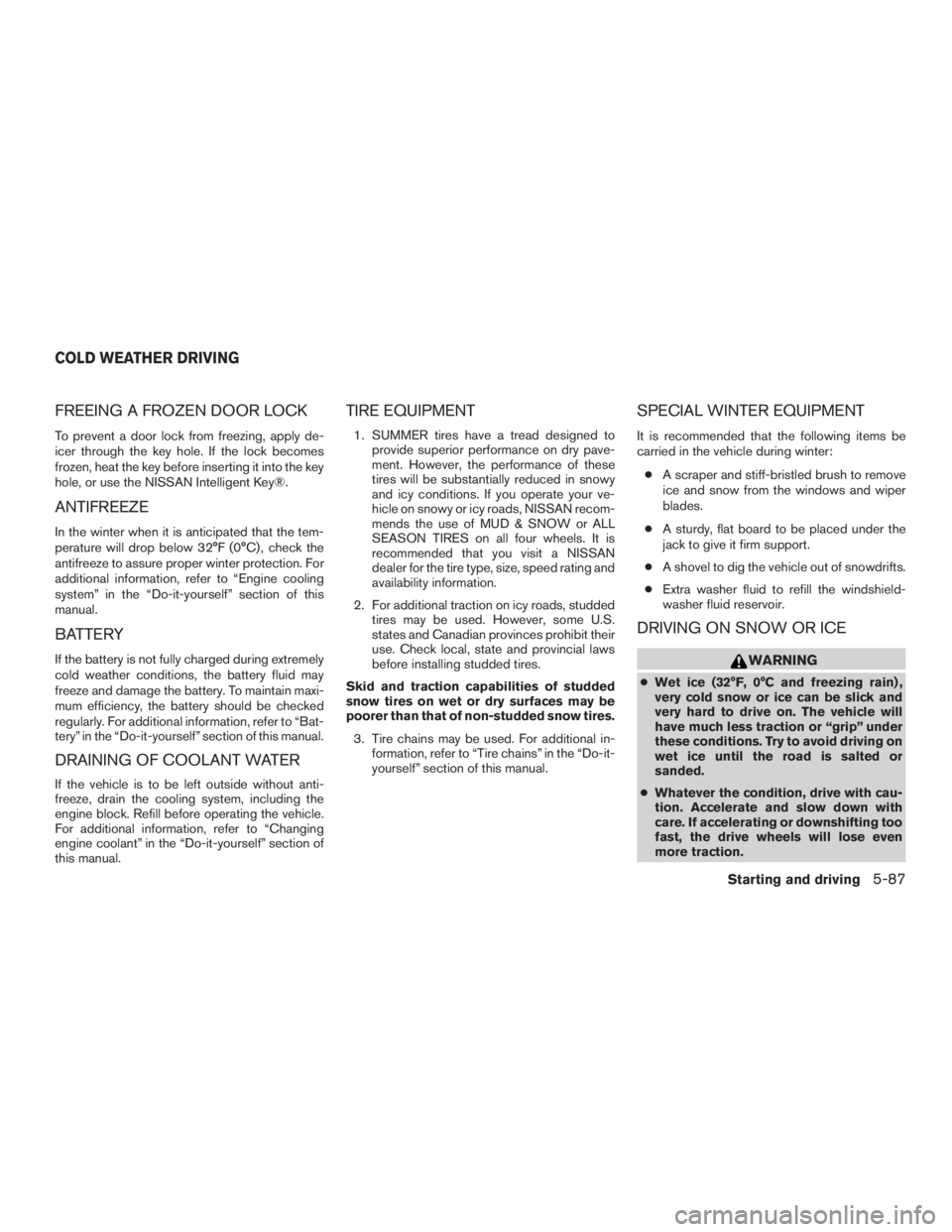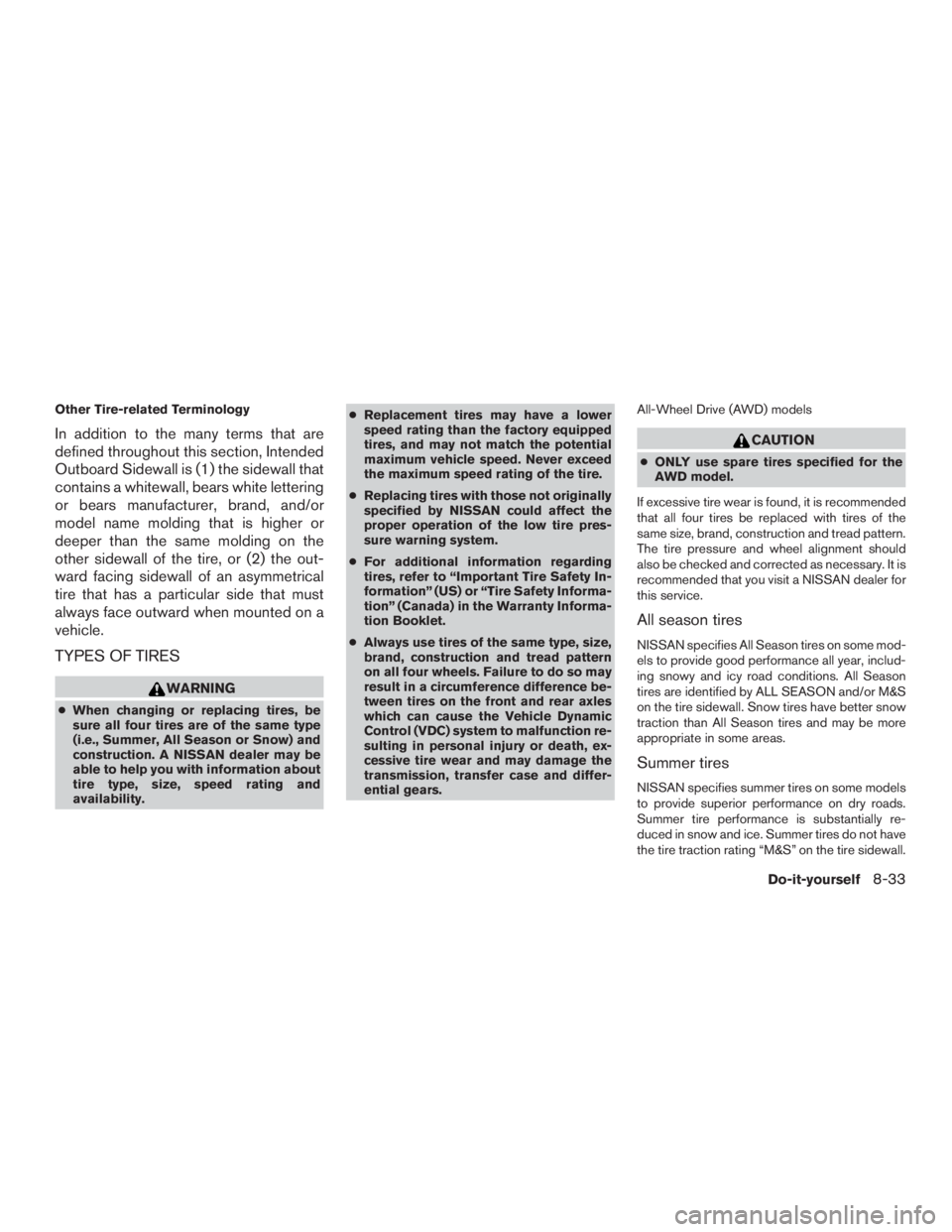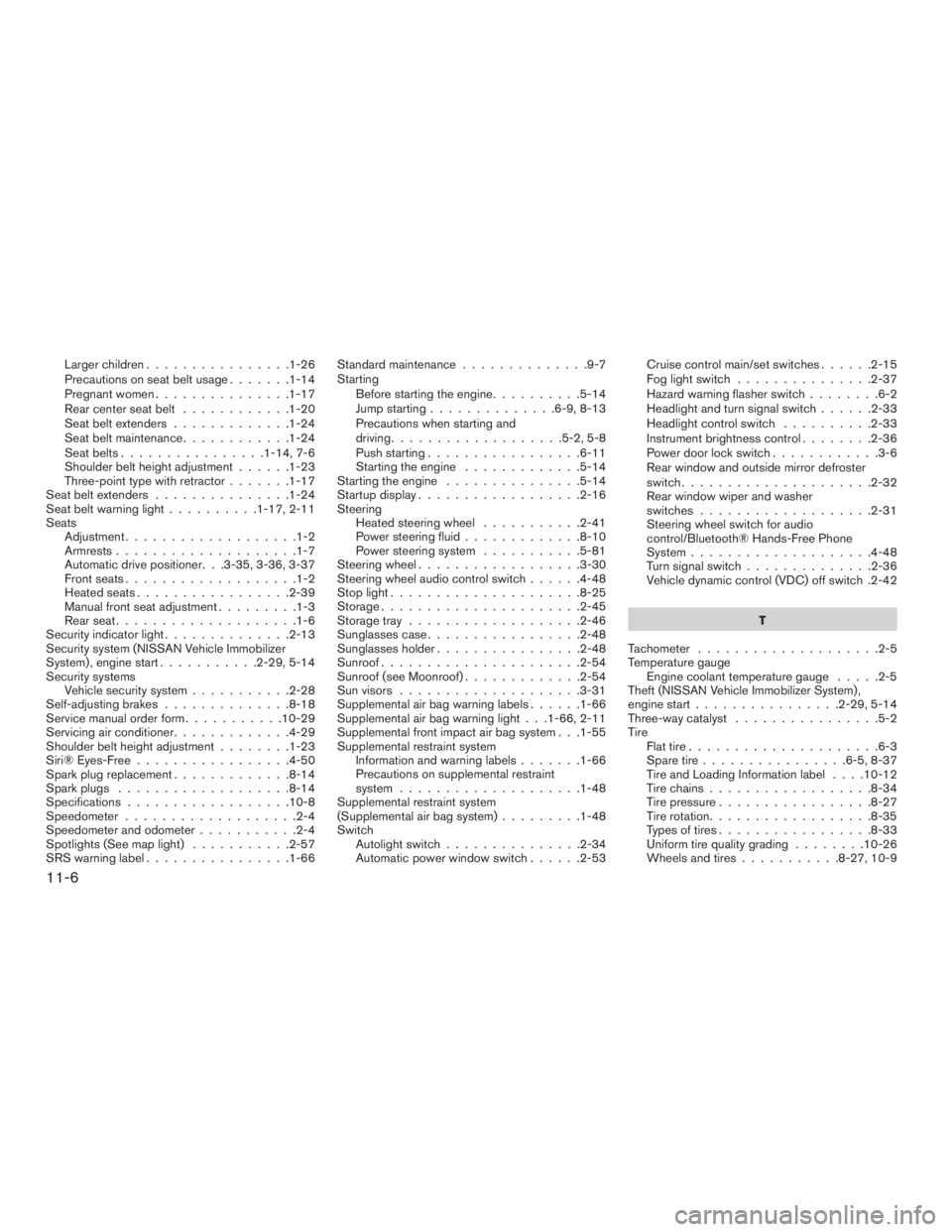2017 NISSAN MURANO PLATINUM tire type
[x] Cancel search: tire typePage 267 of 466

●Do not attempt to test an AWD
equipped vehicle on a 2-wheel dyna-
mometer (such as the dynamometers
used by some states for emissions test-
ing) , or similar equipment even if the
other two wheels are raised off the
ground. Make sure you inform test facil-
ity personnel that your vehicle is
equipped with AWD before it is placed
on a dynamometer. Using the wrong
test equipment may result in drivetrain
damage or unexpected vehicle move-
ment which could result in serious ve-
hicle damage or personal injury.
● When a wheel is off the ground due to
an unlevel surface, do not spin the
wheel excessively.
● Accelerating quickly, sharp steering
maneuvers or sudden braking may
cause loss of control.
● If at all possible, avoid sharp turning
maneuvers, particularly at high speeds.
Your NISSAN vehicle has a higher cen-
ter of gravity than a passenger car. The
vehicle is not designed for cornering at
the same speeds as passenger cars. ●
Failure to operate this vehicle correctly
could result in loss of control and/or a
rollover accident.
● Always use tires of the same type, size,
brand, construction (bias, bias-belted,
or radial) , and tread pattern on all four
wheels. Install tire chains on the front
wheels when driving on slippery roads
and drive carefully.
● Be sure to check the brakes immedi-
ately after driving in mud or water. For
additional information, refer to “Brake
precautions” in this section.
● Avoid parking your vehicle on steep
hills. If you get out of the vehicle and it
rolls forward, backward or sideways,
you could be injured.
● Whenever you drive off-road through
sand, mud or water as deep as the
wheel hub, more frequent maintenance
may be required. For additional infor-
mation, refer to “Maintenance under se-
vere operating conditions” in the “Main-
tenance and schedules” section of this
manual.
Page 344 of 466

FREEING A FROZEN DOOR LOCK
To prevent a door lock from freezing, apply de-
icer through the key hole. If the lock becomes
frozen, heat the key before inserting it into the key
hole, or use the NISSAN Intelligent Key®.
ANTIFREEZE
In the winter when it is anticipated that the tem-
perature will drop below 32°F (0°C) , check the
antifreeze to assure proper winter protection. For
additional information, refer to “Engine cooling
system” in the “Do-it-yourself” section of this
manual.
BATTERY
If the battery is not fully charged during extremely
cold weather conditions, the battery fluid may
freeze and damage the battery. To maintain maxi-
mum efficiency, the battery should be checked
regularly. For additional information, refer to “Bat-
tery” in the “Do-it-yourself” section of this manual.
DRAINING OF COOLANT WATER
If the vehicle is to be left outside without anti-
freeze, drain the cooling system, including the
engine block. Refill before operating the vehicle.
For additional information, refer to “Changing
engine coolant” in the “Do-it-yourself” section of
this manual.
TIRE EQUIPMENT
1. SUMMER tires have a tread designed toprovide superior performance on dry pave-
ment. However, the performance of these
tires will be substantially reduced in snowy
and icy conditions. If you operate your ve-
hicle on snowy or icy roads, NISSAN recom-
mends the use of MUD & SNOW or ALL
SEASON TIRES on all four wheels. It is
recommended that you visit a NISSAN
dealer for the tire type, size, speed rating and
availability information.
2. For additional traction on icy roads, studded tires may be used. However, some U.S.
states and Canadian provinces prohibit their
use. Check local, state and provincial laws
before installing studded tires.
Skid and traction capabilities of studded
snow tires on wet or dry surfaces may be
poorer than that of non-studded snow tires. 3. Tire chains may be used. For additional in- formation, refer to “Tire chains” in the “Do-it-
yourself” section of this manual.
SPECIAL WINTER EQUIPMENT
It is recommended that the following items be
carried in the vehicle during winter:
● A scraper and stiff-bristled brush to remove
ice and snow from the windows and wiper
blades.
● A sturdy, flat board to be placed under the
jack to give it firm support.
● A shovel to dig the vehicle out of snowdrifts.
● Extra washer fluid to refill the windshield-
washer fluid reservoir.
DRIVING ON SNOW OR ICE
Page 402 of 466

Other Tire-related Terminology
In addition to the many terms that are
defined throughout this section, Intended
Outboard Sidewall is (1) the sidewall that
contains a whitewall, bears white lettering
or bears manufacturer, brand, and/or
model name molding that is higher or
deeper than the same molding on the
other sidewall of the tire, or (2) the out-
ward facing sidewall of an asymmetrical
tire that has a particular side that must
always face outward when mounted on a
vehicle.
TYPES OF TIRES
Page 459 of 466

Largerchildren................1-26
Precautionsonseatbeltusage.......1-14
Pregnant women...............1-17
Rear center seat belt ............1-20
Seat belt extenders .............1-24
Seat belt maintenance ............1-24
Seat belts ................1-14,7-6
Shoulder belt height adjustment ......1-23
Three-point type with retractor .......1-17
Seat belt extenders ...............1-24
Seatbeltwarninglight..........1-17,2-11
Seats Adjustment ...................1-2
Armrests....................1-7
Automatic drive positioner. . .3-35, 3-36, 3-37
Frontseats...................1-2
Heatedseats.................2-39
Manual front seat adjustment .........1-3
Rear seat ....................1-6
Security indicator light ..............2-13
Security system (NISSAN Vehicle Immobilizer
System) , engine start ...........2-29,5-14
Security systems Vehicle security system ...........2-28
Self-adjusting brakes ..............8-18
Service manual order form ...........10-29
Servicing air conditioner .............4-29
Shoulder belt height adjustment ........1-23
Siri® Eyes-Free .................4-50
Spark plug replacement .............8-14
Spark plugs ...................8-14
Specifications ..................10-8
Speedometer ...................2-4
Speedometer and odometer ...........2-4
Spotlights(Seemaplight) ...........2-57
SRS warning label ................1-66 Standard maintenance
..............9-7
Starting Before starting the engine ..........5-14
Jump starting ..............6-9,8-13
Precautions when starting and
driving ...................5-2,5-8
Push starting .................6-11
Starting the engine .............5-14
Starting the engine ...............5-14
Startup display ..................2-16
Steering Heated steering wheel ...........2-41
Power steering fluid .............8-10
Power steering system ...........5-81
Steeringwheel..................3-30
Steering wheel audio control switch ......4-48
Stoplight.....................8-25
Storage......................2-45
Storage tray ...................2-46
Sunglassescase.................2-48
Sunglassesholder................2-48
Sunroof......................2-54
Sunroof(seeMoonroof).............2-54
Sun visors ....................3-31
Supplemental air bag warning labels ......1-66
Supplemental air bag warning light . . .1-66, 2-11
Supplemental front impact air bag system . . .1-55
Supplemental restraint system Information and warning labels .......1-66
Precautions on supplemental restraint
system ....................1-48
Supplemental restraint system
(Supplemental air bag system) .........1-48
Switch Autolightswitch...............2-34
Automatic power window switch ......2-53Cruise control main/set switches
......2-15
Fog light switch ...............2-37
Hazard warning flasher switch ........6-2
Headlightandturnsignalswitch......2-33
Headlight
control switch ..........2-33
Instrument brightness control ........2-36
Power door lock switch ............3-6
Rear window and outside mirror defroster
switch .....................2-32
Rear window wiper and washer
switches ...................2-31
Steering wheel switch for audio
control/Bluetooth® Hands-Free Phone
System ....................4-48
Turnsignalswitch..............2-36
Vehicle dynamic control (VDC) off switch .2-42
T
Tachometer ....................2-5
Temperature gauge Engine coolant temperature gauge .....2-5
Theft (NISSAN Vehicle Immobilizer System) ,
engine start ................2-29,5-14
Three-way catalyst ................5-2
Tire Flat tire .....................6-3
Spare tire ................6-5,8-37
Tire and Loading Information label ....10-12
Tire chains ..................8-34
Tire pressure .................8-27
Tire rotation..................8-35
Types of tires .................8-33
Uniform tire quality grading ........10-26
Wheels and tires ...........8-27,10-9
11-6